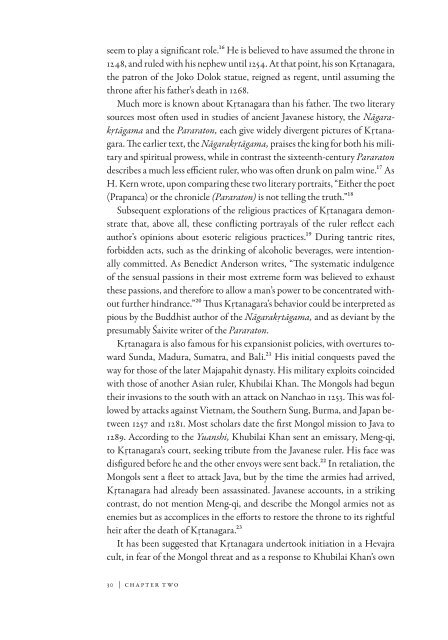Violence and Serenity: Late Buddhist Sculpture from Indonesia
Violence and Serenity: Late Buddhist Sculpture from Indonesia
Violence and Serenity: Late Buddhist Sculpture from Indonesia
Create successful ePaper yourself
Turn your PDF publications into a flip-book with our unique Google optimized e-Paper software.
seem to play a significant role.16 He is believed to have assumed the throne in<br />
1248, <strong>and</strong> ruled with his nephew until 1254. At that point, his son Krtanagara, ˙<br />
the patron of the Joko Dolok statue, reigned as regent, until assuming the<br />
throne after his father’s death in 1268.<br />
Much more is known about Krtanagara than his father. The two literary<br />
˙<br />
sources most often used in studies of ancient Javanese history, the Nāgarakrtāgama<br />
<strong>and</strong> the Pararaton, each give widely divergent pictures of Krtana ˙ ˙<br />
gara. The earlier text, the Nāgarakrtāgama,<br />
praises the king for both his mili-<br />
˙<br />
tary <strong>and</strong> spiritual prowess, while in contrast the sixteenth-century Pararaton<br />
describes a much less efficient ruler, who was often drunk on palm wine.17 As<br />
H. Kern wrote, upon comparing these two literary portraits, “Either the poet<br />
(Prapanca) or the chronicle (Pararaton) is not telling the truth.”18<br />
Subsequent explorations of the religious practices of Krtanagara demon-<br />
˙<br />
strate that, above all, these conflicting portrayals of the ruler reflect each<br />
author’s opinions about esoteric religious practices.19 During tantric rites,<br />
forbidden acts, such as the drinking of alcoholic beverages, were intentionally<br />
committed. As Benedict Anderson writes, “The systematic indulgence<br />
of the sensual passions in their most extreme form was believed to exhaust<br />
these passions, <strong>and</strong> therefore to allow a man’s power to be concentrated without<br />
further hindrance.”20 Thus Krtanagara’s behavior could be interpreted as<br />
˙<br />
pious by the <strong>Buddhist</strong> author of the Nāgarakrtāgama,<br />
<strong>and</strong> as deviant by the<br />
˙<br />
presumably Śaivite writer of the Pararaton.<br />
Krtanagara is also famous for his expansionist policies, with overtures to-<br />
˙<br />
ward Sunda, Madura, Sumatra, <strong>and</strong> Bali.21 His initial conquests paved the<br />
way for those of the later Majapahit dynasty. His military exploits coincided<br />
with those of another Asian ruler, Khubilai Khan. The Mongols had begun<br />
their invasions to the south with an attack on Nanchao in 1253. This was followed<br />
by attacks against Vietnam, the Southern Sung, Burma, <strong>and</strong> Japan between<br />
1257 <strong>and</strong> 1281. Most scholars date the first Mongol mission to Java to<br />
1289. According to the Yuanshi, Khubilai Khan sent an emissary, Meng-qi,<br />
to Krtanagara’s court, seeking tribute <strong>from</strong> the Javanese ruler. His face was<br />
˙<br />
disfigured before he <strong>and</strong> the other envoys were sent back.22 In retaliation, the<br />
Mongols sent a fleet to attack Java, but by the time the armies had arrived,<br />
Krtanagara had already been assassinated. Javanese accounts, in a striking<br />
˙<br />
contrast, do not mention Meng-qi, <strong>and</strong> describe the Mongol armies not as<br />
enemies but as accomplices in the efforts to restore the throne to its rightful<br />
heir after the death of Krtanagara.23 ˙<br />
It has been suggested that Krtanagara undertook initiation in a Hevajra<br />
˙<br />
cult, in fear of the Mongol threat <strong>and</strong> as a response to Khubilai Khan’s own<br />
30 | chapter two
















